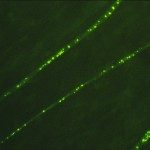Link to Pubmed [PMID] – 14554083
Virology 2003 Sep;314(2):549-61
We report here that rabies virus strains, currently used to immunize wildlife against rabies, induce not only caspase-dependent apoptosis in the human lymphoblastoid Jurkat T cell line (Jurkat-vect), but also a caspase-independent pathway involving the apoptosis-inducing factor (AIF). In contrast, a strain of neurotropic RV that does not induce apoptosis did not activate caspases or induce AIF translocation. Bcl-2 overproduction in Jurkat T cells (Jurkat-Bcl-2) abolished both pathways. ERA infection and production were similar in Jurkat-vect and Jurkat-Bcl-2 cells, indicating Bcl-2 has no direct antiviral effects. Bcl-2 production is naturally upregulated by day 3 in ERA-infected Jurkat-vect cultures. The increase in Bcl-2 levels seems to be controlled by the virus infection itself and results in the establishment of long-term, persistently infected cultures that continue to produce virus. Thus, in infections with live RV vaccine strains, infected cells may be productive reservoirs of virus in the long term. This may account for the high efficacy of live rabies vaccines.

